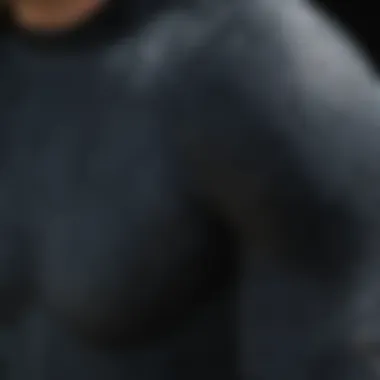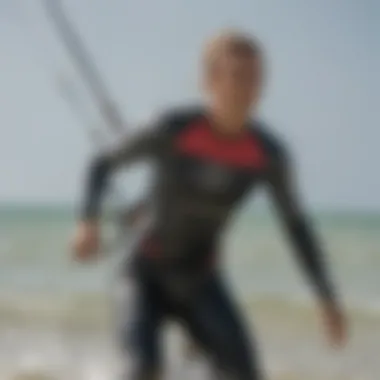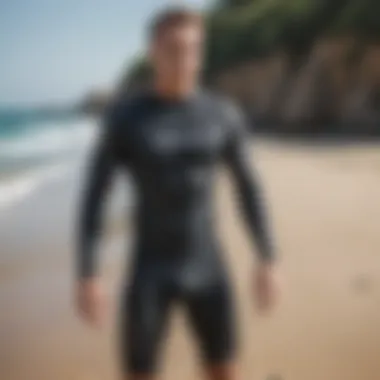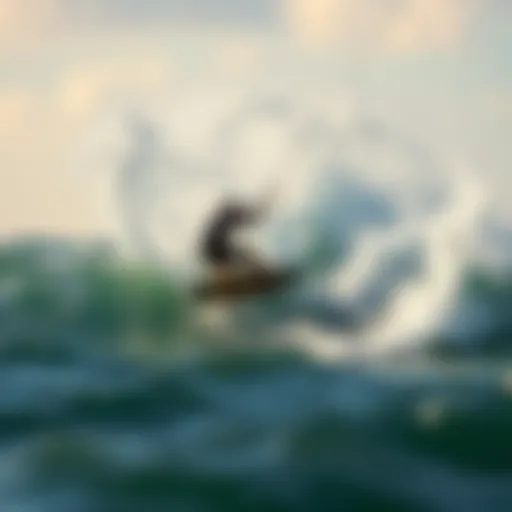Instructor Rash Guards: Enhancing Kiteboarding Safety


Intro
Kiteboarding is a thrilling sport, blending the freedom of surfing with the rush of flying high above the water. As with any sport, the right gear plays a pivotal role in ensuring safety, comfort, and performance. Among the essential equipment for instructors and students alike are rash guards, especially designed for kiteboarding. These specialized garments do much more than just provide protection against sunburn and rash—they signify a commitment to safety and performance, not just for the individual wearing them but also for their students.
Rash guards specifically designed for instructors come with advancements in materials, design features, and functionality. They contribute to a safer and more enjoyable learning experience while allowing instructors to move freely as they teach complex techniques. Let's take a closer look at how these key elements intertwine in the realm of kiteboarding.
Understanding Instructor Rash Guards
In the world of kiteboarding, understanding instructor rash guards isn't just valuable; it’s essential. These garments go beyond mere clothing; they play a pivotal role in the safety, comfort, and performance of instructors who are at the helm of teaching aspiring kiteboarders.
Rash guards boast several benefits that are tailored specifically for the rigorous demands of kiteboarding, making them a non-negotiable element in an instructor's gear. From providing sun protection to enhancing mobility, the relevance of these garments becomes more profound when diving into their unique characteristics and purposes. Let's break this topic down further.
Definition and Purpose
So, what exactly are instructor rash guards? In simple terms, they are form-fitting shirts typically made from synthetic materials like nylon, polyester, or spandex. Designed for water sports, including surfing and kiteboarding, these shirts serve multiple purposes.
- Protection from Sun Exposure: One of the primary functions is to shield the skin from harmful UV rays. Given the prolonged hours many instructors spend under the sun, this protective layer is invaluable.
- Reduced Chafing: Kiteboarding can produce friction between the skin and the equipment or wetsuit. Rash guards help mitigate this issue, providing a smoother surface against the skin.
- Thermoregulation: These garments also assist with temperature control. They help keep the body cool in warm water while providing some warmth in cooler conditions.
In essence, instructor rash guards are designed to enhance a kiteboarding instructor's experience, directly impacting how efficiently and effectively they can teach their students.
Evolution of Rash Guards in Surfing and Kiteboarding
The journey of rash guards traces back to the surfing community, where the original designs emerged as a response to the need for protection in the ocean. Initially, surfers used these garments to avoid irritation caused by surfboards and the salty water. Fast forward to today, the evolution of rash guards in both surfing and kiteboarding reflects significant advancements not just in material but also in functionality.
Today’s rash guards come equipped with technological innovations, such as moisture-wicking capabilities and additional UV protection that far exceeds the early versions. They are also available in a range of cuts, from tight-fitting to loose styles, allowing instructors to choose based on comfort and practicality.
As kiteboarding became more popular, manufacturers recognized the specific needs of instructors. The design transitioned from the purely functional to incorporating stylish elements, ensuring instructors can look good while staying protected.
"The modern rash guard represents a blend of style and functionality, catering to the unique demands of water sports instruction."
In summary, understanding instructor rash guards goes beyond their definition. It involves recognizing their essential role and historical context within the dynamic realms of surfing and kiteboarding. This knowledge is key for instructors and students alike, as it underscores the significance of these garments in creating a safe and effective learning environment.
Key Features of Instructor Rash Guards
The importance of instructor rash guards in kiteboarding cannot be understated. These specialized garments are not just about making a fashion statement on the water; they play a crucial role in ensuring the safety and performance of instructors as they navigate through various conditions. By looking closely at the key features of these rash guards, we can appreciate how they enhance the kiteboarding experience while meeting the distinct needs of instructors.
Material Composition
Nylon vs. Polyester
The choice between nylon and polyester is like picking your sword before heading into a battle. Both materials come with their own sets of strengths. Nylon is often known for its durability and flexibility. It tends to be a more breathable option, which is a big plus for instructors stuck in the sun while teaching. On the other hand, polyester is recognized for its resistance to color fading and shrinkage over time. This means that a well-chosen polyester rash guard could keep looking fresh while holding up against the waves. Each material also contributes to the overall stretch and adaptability of the garment, essential for the dynamic movements involved in kiteboarding.
Spandex and Stretchability
You can't speak about comfort without mentioning spandex. This little gem offers an unmatched level of stretchability, allowing instructors to move freely while performing tricks or guiding students. It's the secret sauce that makes rash guards fit snugly without constricting movement. When you're in the middle of a lesson, the last thing you want is to feel like a sausage in a casing. Spandex gives that ease and flexibility that every instructor craves. However, it’s worth mentioning that while spandex adds stretch, it may require more care in washing to maintain its form.
UV Protection Levels
Sun protection is paramount, especially when instructors are often exposed to harsh sunlight for extended periods. Rash guards are designed with various UV protection levels, allowing instructors to choose garments that can block harmful rays. The higher the UPF rating, the better the protection. A fine rash guard can offer an additional layer of safety against sunburns, making it easier to focus on teaching rather than worrying about skin damage. However, it’s essential to understand that UV protection doesn’t last forever, so regular replacement is advised.
Design Innovations
Fit and Style Variations
Modern rash guards come in all sorts of designs and cuts, catering to different body shapes and preferences. This variety is important as it allows instructors to feel comfortable and confident while teaching. A well-fitting rash guard should complement the instructor's physique while allowing for unrestricted movement. The styles have come a long way, with options ranging from fitted to relaxed cuts, ensuring that there's something for everyone. However, it’s crucial to remember that a trendy design should never compromise functionality—after all, that’s what these garments are fundamentally about.
Color and Pattern Choices
Color and pattern options in rash guards can be as vibrant as the ocean itself. Instructors often use these choices to express their personal style or to remain easily identifiable to students. Bright colors can be beneficial, especially in crowded waters, as they help others spot the instructor quickly. On the downside, be cautious with dark shades near the sun, as these may absorb heat more readily. Ultimately, the right color choice will balance visibility with personal preference.
Integration with Other Gear
A well-designed rash guard doesn’t stand alone; it often integrates with other kiteboarding gear seamlessly. Many rash guards come with features like loops for attaching harnesses or additional padding. This integration is key because it ensures that instructors have all they need at their fingertips without having to fumble around. However, instructors should be mindful of how these features can influence comfort levels during prolonged use. Judicious selection based on personal experiences can make a world of difference in performance.
Functional Benefits


Thermoregulation
Thermoregulation is a pivotal aspect to consider. On scorching hot days, instructors need to stay cool, while in cooler weather, maintaining body heat becomes the challenge. Many rash guards are now made to assist in thermoregulation, balancing body temperature during extreme conditions. The innovative design works to wick moisture away from the skin, promoting evaporation and ensuring that instructors stay comfortable. A downside might be that not all rash guards perform equally, so it’s essential to seek reputable brands.
Chafing Prevention
When you're out on the water all day, the last trouble you want is chafing. High-quality rash guards are designed to prevent this irritating issue, especially in areas where gear might rub against the skin. The strategic placement of seams and panels has evolved to reduce friction dramatically. However, not all rash guards are created equal in this regard, so instructors should pay close attention to the make and design during their selection process.
Hydrodynamics
Hydrodynamics refers to how water moves around the garment when an instructor is kiteboarding. A well-crafted rash guard should minimize drag, helping instructors glide through the water with greater efficiency. This aspect is vital, as it often translates to better performance and improved energy conservation while teaching. However, with the continued innovations in design, there’s always room for improvement, warranting periodic reassessment of the gear as technology progresses.
"The right rash guard is not merely an accessory—it's an instructor's ally in navigating the waves of success."
In summary, understanding the key features of instructor rash guards is essential for making informed choices. By considering factors like material composition, design innovations, and functional benefits, instructors can select gear that enhances their performance while ensuring safety in the water.
Importance of Rash Guards for Instructors
Rash guards play a fundamental role in ensuring that kiteboarding instructors can perform their duties effectively while offering a layer of safety to themselves and their students. In this section, we will explore some critical elements that underline the importance of these garments. They serve not only as a protective barrier against environmental elements but also enhance overall performance. The safety aspects cannot be overstressed, especially when dealing with harsh sunlight and the inherent risks of water sports.
Safety Considerations
Protection Against Sun Exposure
One of the prominent features of instructor rash guards is their ability to protect against sun exposure. When instructors are out on the water, they're at the mercy of UV rays, which can lead to serious skin conditions over time, especially without proper protection. Rash guards are often designed with UV-blocking technology that can substantially reduce the absorption of harmful rays.
The fabrics used commonly have a UPF rating, which indicates how well they guard against UV light. This feature is widely recognized as an essential cover-up for those spending extended hours outside. It's a beneficial choice that combines both fashion and function, providing peace of mind to those teaching under the blazing sun. Instructors who prioritize suncare can shield themselves from potential skin damage and keep their focus on students, free from worry about sunburns.
Reduced Risk of Injury
In addition to sun protection, rash guards also contribute significantly to minimizing injury risks. When kiteboarding, instructors may find themselves in tricky situations where falls or collisions are inevitable. Rash guards are typically made from materials that are resistant to abrasions, providing an additional layer of protection to the skin.
A key characteristic here is the snug, streamlined fit of most rash guards, which helps prevent rashes and cuts from board edges or other equipment. This feature is particularly beneficial on windy days when the risk of falling increases. By wearing these garments, instructors can focus more on delivering effective lessons rather than worrying about sustaining injuries, enabling a safer teaching environment.
Performance Enhancement
Maximizing Mobility
Another crucial aspect of rash guards is their capacity to maximize mobility. Kiteboarding demands a range of movements, from jumping and twisting to rapid directional changes. Instructors need to maneuver efficiently, and any clothing that hinders this could be detrimental to performance. Rash guards are designed with stretchable materials like spandex, allowing for heightened flexibility, meaning that every quick turn or leap is executed with ease.
The lightweight nature of these garments ensures that instructors won't feel weighed down while performing complex tasks. This is why opting for a rash guard that fits snugly, yet comfortably, is often the preferred choice among experienced instructors. Achieving optimal mobility can significantly enhance the overall quality of instruction.
Increasing Endurance
Lastly, the aspect of endurance cannot be overlooked when discussing performance enhancement. The fabric technology employed in rash guards is tailored to wick away moisture, ensuring the wearer stays dry and comfortable during lessons. Staying sweat-free can maintain body temperature, which plays a significant role in overall endurance levels, especially on warm days.
The breathability factor of rash guards allows instructors to stay cool while working hard, thereby prolonging their stamina. This is often hailed as a worthwhile investment for those looking to sustain energy throughout long sessions on the water. Moreover, increased endurance ultimately translates to effective teaching, and instructors keen to keep up with students will find this feature invaluable.
Choosing the Right Rash Guard
When it comes to kiteboarding, particularly for instructors on the water, choosing the right rash guard can make or break an experience. The variety of options available today means that instructors need to think carefully about what will suit their individual needs while providing comfort, functionality, and protection. The right choice can enhance performance on the water considerably, ensuring that conditions—whether they are chilly or sunny—are managed appropriately, contributing to an optimal teaching environment.
Sizing and Fit
Body Types and Rash Guards
A key aspect in selecting a rash guard is knowing how different body types align with what’s available in the market. The fit of a rash guard directly influences an instructor's mobility and comfort out on the waves. For example, a slim instructor may prefer a tighter fit to avoid any excess fabric that might impede movement. Conversely, broader body types often benefit from a slightly looser fit, ensuring there's enough room for movement without feeling constricted. It’s crucial for instructors to try on different styles—some brands offer cut variations catering to specific body types, enhancing the overall experience. This attention to fit can help prevent unnecessary distractions during lessons and engage students more effectively.
Understanding Size Charts
Often overlooked, size charts are an essential tool in selecting a rash guard. Each brand may have contrasting sizing standards, and using these guides can prevent the disappointment of receiving a poorly fitting garment. Familiarizing oneself with these charts allows instructors to make informed decisions, avoiding garments that are too tight or too loose. A well-fit rash guard not only improves comfort but also builds confidence during lessons, as instructors don’t have to worry about readjusting their gear while navigating the wind and surf. Noticing the differences in sizing can help instructors find that right balance between snugness and comfort, which is vital when they’re spending hours in the water.
Selecting Materials
Choosing Breathable Fabrics
Breathability in fabrics is a significant factor in maximizing comfort while kiteboarding. Rash guards made of breathable materials offer effective moisture management, crucial for instructors who can find themselves sweating under the sun while engaging in rigorous activities. A fabric that allows for air circulation keeps instructors cooler and enables unrestricted movement, making it a beneficial choice. In environments with intense sun exposure, the right breathable material can effectively wick away moisture, promoting a more enjoyable experience. Look for features like mesh panels or lightweight fabric blends, as these enhancements can help instructors maintain their cool even when the sun is blazing.


Assessing Durability
The durability of a rash guard is another fundamental consideration. In a sport like kiteboarding, where both saltwater and sun exposure are at play, instructors need gear that can withstand tough conditions and prolonged use. Assessing durability means looking at stitching quality, fabric resilience, and overall construction. While it might be tempting to go for less expensive options, opting for high-quality material ensures the rash guard will last longer and provide continuous performance through various lessons and conditions. A durable garment translates to reduced long-term costs and a reliable partner in an instructor’s kiteboarding career. Therefore, instructors should pay attention to wear indicators, such as fading or seam fraying, which can signal when it’s time for an upgrade.
Price Considerations
Budget-Friendly Options
In an environment where instructors may still be starting or testing their waters, budget-friendly rash guards become crucial. Many good-quality options exist at lower price points without sacrificing essential features such as UV protection and breathability. Instructors can often find deals from reputable brands that offer their products on sale or even in outlets. Opting for these budget options allows instructors to maximize their spending—enabling them to invest in other crucial teaching tools while remaining protected. However, it’s important to ensure that these options still meet adequate quality standards; a cheap rash guard that doesn't perform well can lead to negative experiences on the water.
Premium Products
On the other end of the scale, premium rash guards can be a worthwhile investment. These typically feature cutting-edge materials and design innovations that can significantly enhance performance and comfort. For instance, premium products may utilize advanced UV protection technologies or offer ergonomic designs that allow for greater mobility on the water. While the upfront cost may be higher, the durability and long-term benefits often make them a sound choice for busy instructors. Also, many premium products come with warranties or guarantees, adding further peace of mind. Instructional effectiveness on the water can often correlate with the quality of gear, and in instances where the price aligns with the quality, opting for the best is often worth it.
Maintenance and Care of Rash Guards
Taking proper care of instructor rash guards is essential not just for longevity, but also for maintaining their effectiveness in kiteboarding. A well-maintained rash guard can enhance performance, protect the skin, and uphold its protective qualities throughout the season. With constant exposure to the elements—saltwater, sunlight, and sand—the longevity of these garments hinges on appropriate maintenance.
Cleaning Techniques
Washing Guidelines
When it comes to washing rash guards, it's vital to follow a few simple guidelines to ensure they endure the wear and tear of both time and use. The key characteristic here is to wash them with cold water. This choice helps preserve the elasticity of the fabric while preventing color fading. Typically, using a mild detergent is recommended, as harsh chemicals can diminish the UV protection qualities embedded in the fabric.
One unique consideration is that many rash guards are made from synthetic materials. These fabrics can attract build-up, such as sweat and salt, if not cleaned properly. Therefore, rinsing them immediately after use, followed by a gentle cycle wash, proves beneficial. People often overlook the importance of not using fabric softeners. Though they might seem helpful, they can coat the fibers and detract from the performance and protective features of the garment.
Drying Recommendations
Drying rash guards properly is as crucial as washing them correctly. Air-drying is the prevailing choice because it minimizes damage. Hang the rash guard in a shady spot, avoiding direct sunlight as it can lead to deterioration over time.
A unique feature of air-drying is that it conserves the fabric's flexibility, which is often compromised under high heat from tumble dryers. However, instructors in a rush might be tempted to use a low heat cycle; this should be approached with caution. Even low settings can cause fabric shrinkage or distort structural integrity. Thus, staying clear of the dryer is usually the wise path to maintain its fit and function.
Storage Practices
Avoiding Sunlight Damage
Storing rash guards properly is imperative to protect them from undue damage, particularly from sunlight. The sun’s UV rays can be relentless, weakening fabric fibers, causing fading, and impacting the garment's overall performance features. In particular, instructors, who often rely on these garments day after day, need to ensure they are placed in shaded areas or stored away from direct sunlight.
Utilizing a drawer or a closet dedicated to sports gear can keep them safe from harmful exposure. Faded garments not only look less professional, but they also lose their distinctive functional qualities that instructors depend on during lessons.
Proper Folding Methods
Finally, how one folds a rash guard matters—a lot more than one might think. Proper folding methods aid in retaining the shape of the garment. Instead of crumpling or throwing it into a bag, a straightforward fold helps to prevent creases and diminishes the risk of fabric distortion. This practice of smooth folding can also enhance the longevity of elasticity in the fabric.
Lay the rash guard flat, fold the sleeves towards the center, and then fold in half. This not only saves space but also maintains the integrity of the item. Investing time in proper storage pays dividends, ensuring that when instructors grab their gear, it’s ready to provide optimal performance under the sun.
"A little care goes a long way in keeping your gear in top shape, ultimately enhancing your performance on the water."
Through these essential practices—cleaning, drying, and storing—kitesurfing instructors can ensure their rash guards are always ready for action, maintaining their protective benefits while extending their life.
Environmental Impact and Sustainability
In the world of kiteboarding, not only does the thrill of the wind and water excite enthusiasts, but there’s also growing awareness of the environmental impact of gear and apparel. Instructor rash guards play a significant role in this conversation, representing a bridge between performance needs and sustainable practices. With the increasing demand for eco-conscious products, understanding the sustainability aspects of rash guards is vital for both instructors and consumers alike. It encourages a shift towards making better choices that respect the environment, enhancing the appeal of kiteboarding as a responsible sport.
Eco-Friendly Materials
Recycled Fabrics
Recycled fabrics have garnered attention in the kiteboarding community for their ability to reduce waste and reliance on virgin materials. These materials are made from post-consumer or post-industrial waste, such as discarded plastic bottles or old garments, which are reprocessed into new fabrics. This approach not only conserves natural resources but also significantly lowers carbon emissions associated with production.
One of the standout characteristics of recycled fabrics is their durability. They can match or even exceed the performance of traditional fabric while contributing less to landfill accumulation. Using recycled materials ensures that instructors wear garments that promote sustainable practices while still providing the required protection and comfort for demanding activities.
However, there are unique features to consider. While the adoption of recycled materials is a step forward, the process itself can sometimes involve chemical treatments that may not be entirely environmentally friendly. Thus, it's important for consumers to evaluate each product thoroughly, balancing sustainability with safety and performance. Overall, these fabrics represent a beneficial trend in the industry that merges environmental responsibility with functionality.
Biodegradable Options


Biodegradable options in rash guards are another fascinating development in the ongoing effort to curb environmental impact. These materials are designed to break down more easily in natural environments, reducing the long-term waste produced by discarded gear. Made from organic substances like plant fibers or specially designed polymers, they have the potential to revolutionize how kiteboarding materials are perceived in the market.
The key characteristic of biodegradable options is indeed their potential to decompose in a relatively short period compared to traditional synthetic fabrics. This feature is particularly appealing for eco-conscious kiteboarders looking to minimize their footprint. The concept of wearing gear that won’t linger in landfills for centuries aligns with a broader movement toward sustainable outdoor practices.
Nonetheless, biodegradable materials can sometimes pose a challenge in terms of performance, particularly in high-stress environments like kiteboarding. It's essential to weigh the benefits of reduced environmental impact against the durability and effectiveness of these fabrics. While they represent a promising choice, users may need to consider how often they might wear or discard them.
Reducing Plastic Waste in Kiteboarding
Brands Leading the Change
Several brands have taken proactive measures to lessen plastic waste associated with kiteboarding gear. Companies like Patagonia and O'Neill are notable for their commitment to sustainability, consistently innovating in their product lines to incorporate recycled and eco-friendly materials. Their dedication not only helps reduce wastage in manufacturing but also sets a standard for others in the industry to follow.
These brands often highlight their use of recycled plastics in their marketing strategies, demonstrating transparency and availability of their eco-conscious practices. In doing so, they not only appeal to a growing demographic of environmentally aware consumers but also contribute significantly to the larger conversation about sustainability in water sports. Choosing to purchase from these brands can empower consumers, making them agents of change in their sport of choice.
Consumer Responsibility
Consumer responsibility can't be overlooked when discussing sustainability in kiteboarding. Every purchase made carries implications for the environment. By opting for instructor rash guards that are sustainable or produced by responsible companies, consumers have the power to influence manufacturing practices and push for more environmentally friendly options.
The key characteristic of consumer responsibility is awareness. Educated consumers are better equipped to make choices that align with their values regarding sustainability. Furthermore, they can foster a collective effort in the kiteboarding community to prioritize environmental preservation.
However, this responsibility also comes with challenges. With a plethora of products on the market, distinguishing genuinely sustainable offerings from those that are merely marketed as such can be daunting. Educating oneself about the materials and practices can go a long way toward making informed decisions that positively impact the environment and ensure the longevity of kiteboarding as a sport.
"The choices we make today in our gear can shape the future of our oceans and coastlines tomorrow."
In summary, the environmental impact and sustainability of instructor rash guards in kiteboarding hold a crucial place in the discourse surrounding this exhilarating sport. By embracing eco-friendly materials, supporting brands leading the change, and taking responsibility as consumers, we can make meaningful strides toward reducing our environmental footprint, ensuring the beauty of our natural playgrounds remains for generations to come.
Reviews of Notable Instructor Rash Guards
When it comes to kiteboarding, the choice of instructor rash guards can significantly affect both the performance of the instructor and the learning experience of their students. This section aims to underline the importance of selecting the right rash guards by reviewing notable options available in the market. It highlights elements such as durability, comfort, and specific features tailored for instructors, making it an essential guide for instructors and brands alike.
Top Performance Brands
In the realm of instructor rash guards, certain brands have established themselves as front-runners due to their commitment to quality and performance. Here's a closer look at a few top brands worth considering:
- O'Neill: Known for its robust designs that balance functionality and comfort, O'Neill offers rash guards that excel in sun protection and easy movement.
- Rip Curl: Rip Curl's reputation in surf wear spills over into kiteboarding with innovative designs that promote agility on the water.
- Quiksilver: This brand often integrates cutting-edge materials that not only protect against UV rays but also enhance thermal comfort, key for long sessions in varying conditions.
- Patagonia: With a strong focus on sustainability, Patagonia crafts rash guards from recycled materials, making them a wise choice for environmentally-conscious instructors.
- Billabong: Features bold styles and excellent fit options, perfect for those who want to make a statement while ensuring their gear performs at the highest standard.
These brands set a benchmark in the market, ensuring that instructors have access to clothing that can withstand the rigors of teaching while maintaining style and comfort.
Comparative Analysis of Features
Assessing rash guards involves more than just selecting a brand; it's critical to compare their features to find the best fit for an instructor’s specific needs. Here’s a breakdown of key areas to consider:
- Material: Rash guards typically use combinations of nylon, polyester, and spandex. Higher-quality materials can offer better UV protection and durability. For example, a blend of polyester and spandex might provide more stretch and comfort, which is vital for dynamic movements involved in kiteboarding.
- Fit and Comfort: An ideal rash guard should fit snugly without restricting motion. Look for styles that cater to various body shapes. Some brands provide specific cuts for women and men, which can make a world of difference.
- UV Protection: Rash guards are not just for preventing rashes; they offer crucial UV protection. Pay attention to the UPF rating. A higher UPF (such as 50+) indicates better protection against harmful sun exposure.
- Additional Features: Some rash guards boast antimicrobial properties, which prevent odor from sweat retention. Others might integrate features like thumbholes or pockets. These details can enhance functionality.
- Durability: Given the wear and tear from ocean elements, durability is paramount. Look for reinforced stitching and quality material that withstands regular exposure to saltwater.
"The right rash guard not only protects skin but also enhances performance in the water. Make it count."
By deeply analyzing these features, instructors can select rash guards that not only meet their personal style but also deliver on performance and comfort, essential components for effective teaching under various conditions. Choosing wisely ensures that instructors can focus on what they do best – teaching kiteboarding safely and efficiently.
Future Trends in Rash Guard Development
The landscape of water sports is constantly evolving, and with it, instructor rash guards are adapting to meet the demands of both performance and sustainability. As kiteboarding gains popularity, understanding the future trends in rash guard development becomes crucial for instructors and enthusiasts alike. This section will explore the potential technological advancements and the integration of smart technologies that promise to change the game.
Technological Advancements
Rash guard technology is making waves these days. New materials and manufacturing processes have emerged, pushing the boundaries of what these garments can do. For instructors who spend hours in the sun and water, having gear that evolves with their needs is essential.
One notable trend is the advancement of moisture-wicking fabrics. Unlike traditional materials, modern moisture-control fabrics actively draw sweat away from the skin, keeping instructors cool and dry even during the most intense sessions. Furthermore, developments in lightweight, breathable materials allow for greater freedom of movement, turning a cumbersome experience into a more fluid one.
In addition to comfort, these innovations have significant safety implications. Rash guards that incorporate enhanced UV protection technology help combat the sun's harsh rays. They can offer a wide range of UV protection ratings, ensuring instructors remain safeguarded while teaching students. This aspect cannot be understated; instructors are often exposed for extended hours, so equipping themselves with the right gear is a critical consideration.
Incorporating Smart Technologies
Imagine a rash guard that does more than just cover your skin. With the ongoing rise of smart technologies, the integration of sensors into rash guards could fundamentally change the experience of water sports.
Some companies are unveiling prototypes that include biometric sensors. These devices can track vitals like heart rate and body temperature, giving instructors valuable feedback about their physical state during lessons. This information can lead to improved performance and safety, as instructors will be better informed about their limits.
In addition, GPS technology could soon find its way into instructor gear. By incorporating this technology, instructors could monitor their movements on the water, analyzing patterns to improve technique or adjust teaching methods based on real-time data. Imagine a day on the water being documented not just through memory, but via technology that helps perfect skills.
The future of instructor rash guards looks promising, with a focus on enhancing both performance and safety through technological advancements and smart integrations. As these trends gain traction, it's important for instructors to stay informed and adapt their gear to maximize the benefits.
"The next wave of rash guard development will merge traditional functionality with cutting-edge technology, creating garments that not only protect but also enhance the overall experience for kiteboarding instructors."
Staying ahead of these trends ensures that instructors remain at the top of their game, providing an optimal learning environment for their students while also prioritizing their own safety and comfort.







